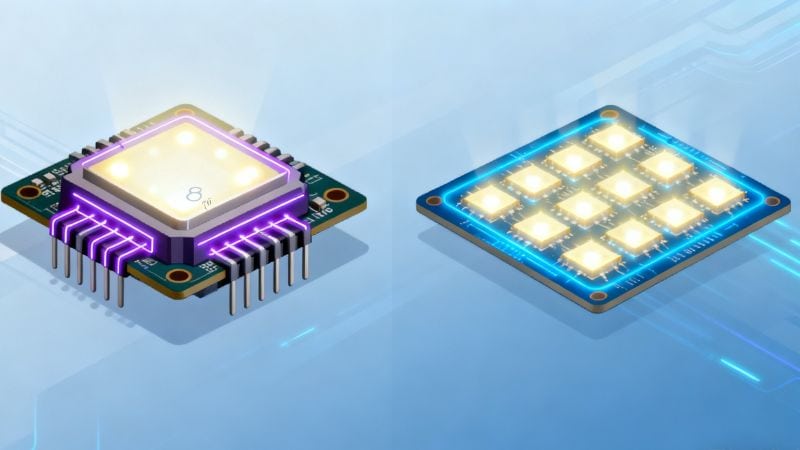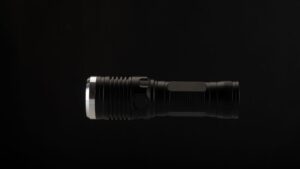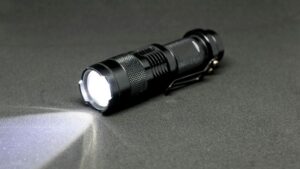COB (Chip on Board) and SMD (Surface Mount Diode) are the two dominant types of LED technologies available today. This guide will break down everything you need to know about COB and SMD LEDs, so you can make an informed decision and say goodbye to bad lighting for good.

What are COB LEDs?
Imagine a bunch of tiny LED chips packed closely together to work as one giant, powerful light source. That’s the essence of a COB LED. The “Chip on Board” name comes from how multiple LED chips are bonded directly onto a single substrate (like a small ceramic or aluminum plate) to form one unified module.
Key Characteristics of COB LEDs:
- Panel-like Appearance: Instead of seeing individual points of light, a COB LED looks like a single, glowing panel. This creates a very uniform and consistent light.
- Simple Circuit: COB LEDs have a simple design with just one circuit and two contacts to power the entire chip, regardless of how many diodes are on it.
- Single-Color Focus: Because of their design, COB lights are fantastic for powerful, single-color applications.
They are known for being a very high-density light source, which is why they can produce such intense, uniform brightness from a small area.
What are SMD LEDs?
Now, let’s talk about the other major player: SMD, or “Surface Mount Diode.” Unlike the all-in-one approach of COB, SMD technology involves mounting individual LED chips directly onto a printed circuit board (PCB). If you’ve ever seen an LED strip light with its rows of individual light points, you’ve seen an SMD LED in action.
Key Characteristics of SMD LEDs:
- Versatility is Key: The biggest advantage of SMD LEDs is their versatility. Because each chip is independent, they can be designed to change colors. The famous “RGB” (Red, Green, Blue) lights that can produce millions of hues are made possible by SMD technology.
- Variety of Sizes: SMD chips come in various sizes, often identified by a number like “SMD 5050” or “SMD 2835.” These numbers simply refer to the dimensions of the chip.
- Individual Circuits: Each SMD chip has its own circuit, which allows for the complex color-changing and individual control features.
COB vs. SMD: A Head-to-Head Comparison
So, when it comes down to it, which one is better? The honest answer is: it depends on what you need. Let’s break down their strengths and weaknesses.
| Feature | COB LED | SMD LED |
| Light Quality | High-quality, uniform light, less glare | More glare, but wider beam angle |
| Brightness | High light intensity | Varies by chip size and number |
| Energy Efficiency | More energy-efficient | Less energy-efficient |
| Heat Dissipation | Better heat management | Less efficient heat dissipation |
| Cost | Higher initial cost | Lower initial cost |
| Color Options | Limited to single color | Wide range of colors (RGB) |
| Lifespan | Longer lifespan | Shorter lifespan |
| Applications | Spotlights, downlights, high-bay lighting | Strip lights, light bulbs, signage |
Light Quality (Brightness, Glare, and Uniformity)
COB LEDs are the clear winner when it comes to light quality. Because all the LEDs are packed into one small area, they produce a single, uniform light that looks clean and focused. This design, often paired with a reflector, dramatically reduces glare and creates a softer light that’s easier on the eyes.
SMD LEDs, on the other hand, produce light from many individual points. This can create a “starry night” effect, which can result in more glare. However, this design also allows for a wider beam angle, making them great for illuminating large areas.
Energy Efficiency and Power Consumption
If you’re looking to save on your energy bills, COB is the way to go. COB LEDs are more energy-efficient, meaning they produce more light (lumens) for every watt of electricity they consume. In some cases, COB technology can lead to energy savings of up to 40% compared to SMD technology. That’s a significant saving over the life of the bulb!
Heat Dissipation and Thermal Management
LEDs create heat, and managing that heat is crucial for their performance and longevity. COB LEDs excel here. By mounting the chips directly to a substrate that often acts as a heat sink, they transfer heat away much more effectively. Better heat management means a longer, more reliable life.
SMD LEDs don’t dissipate heat as well, which can sometimes lead to a shorter lifespan, especially if they are used in enclosed fixtures without proper ventilation.
Cost (Initial and Long-Term)
Initially, SMD LEDs are cheaper to produce, making them more affordable upfront. However, the story changes when you look at the long-term cost. While COB LEDs have a higher initial price tag, their superior energy efficiency and longer lifespan mean they often end up being more cost-effective over time.
Color Options
This is where SMD LEDs truly shine. Their multi-chip, multi-circuit design is perfect for creating vibrant, color-changing (RGB) lights. If you need dynamic lighting for accent walls, signage, or mood lighting, SMD is your best bet. COB technology is primarily used for single-color applications.

A Note on New Tech: The Rise of Flip-Chip COB
The world of LEDs is always evolving. A recent innovation known as “flip-chip” technology is making COB LEDs even better. This advanced manufacturing method improves both energy efficiency and heat dissipation, making the latest generation of COB lights incredibly powerful and sustainable.
Practical Applications: When to Choose COB vs. SMD
Let’s make this practical. When should you choose one over the other?
Choose COB LEDs for:
- Architectural Lighting: Perfect for spotlights and track lights that highlight features of a room or building.
- High Ceilings: In spaces like warehouses, workshops, or rooms with vaulted ceilings, COB downlights and high-bay lights provide the powerful, focused light needed to reach the ground.
- Street Lights & Industrial Settings: Their durability and excellent heat management make them ideal for demanding outdoor and industrial environments.
Choose SMD LEDs for:
- General Home Lighting: Standard light bulbs for kitchens, bathrooms, and living rooms often use SMD technology.
- Accent & Decorative Lighting: LED strip lights that go under cabinets, behind TVs, or along coves are almost always SMD.
- Signage & Displays: When you need vibrant colors and dynamic effects, SMD is the only choice.
Conclusion: Making the Right Choice for Your Needs
As you can see, the “COB vs. SMD” debate doesn’t have one simple winner. The best choice truly depends on what you’re trying to achieve.
- If your priority is high-quality, uniform, and energy-efficient light for focused applications, COB is your champion.
- If you need colorful, versatile, and wide-angle lighting for decorative or large-area applications, SMD is the way to go.
Now that you’re an expert on LED technology, you’re ready to make the perfect lighting choice. Ready to upgrade? Head over to mfopto.com to explore our wide selection of high-quality COB and SMD lighting solutions
Frequently Asked Questions (FAQs)
1. Which is better for photography and videography?
For professional photo and video work, COB LEDs are almost always the superior choice. Because they produce a single, uniform source of light, they mimic a natural light source (like the sun) more closely. This results in softer shadows and a more flattering, high-quality light with no weird “multi-shadow” effects that can sometimes be created by the individual points of an SMD LED.
2. Are COB LEDs dimmable?
Yes, most COB LEDs are dimmable, just like their SMD counterparts. However, it’s essential to ensure that both the COB light fixture and the dimmer switch you are using are compatible. Using an incompatible dimmer can lead to flickering or damage to the light.
3. Why do my SMD strip lights get so hot?
This comes down to heat dissipation. SMD strips pack many individual diodes onto a flexible board that doesn’t handle heat as well as the ceramic or aluminum substrate of a COB light. If the strip is on for a long time, especially in an enclosed space without airflow, the heat can build up. This is why it is often recommended to install SMD strips on an aluminum channel, which acts as a heat sink to draw heat away and prolong the life of the strip.
4. Are there flexible COB strip lights?
Yes! This is a newer development in the lighting world. Flexible COB strip lights offer the best of both worlds: the smooth, seamless glow of a COB light with the versatility of a traditional SMD strip. They create a flawless line of light with no visible dots, making them perfect for high-end architectural and under-cabinet lighting.
5. Which technology is physically larger?
Individually, an SMD chip is very small. However, a COB LED packs hundreds or even thousands of diodes into a very dense, compact area. So while a single SMD chip is tiny, a complete COB module is often more compact than an SMD array of equivalent brightness, as the SMD array would need more space between chips on its circuit board.





